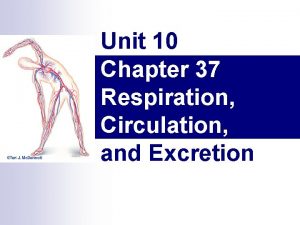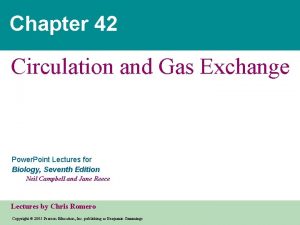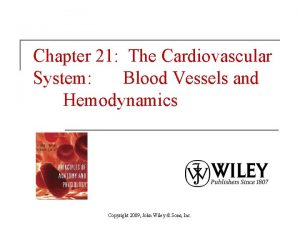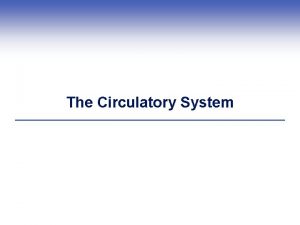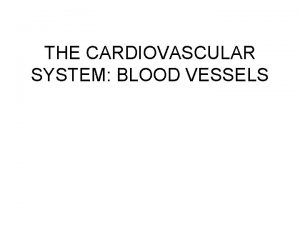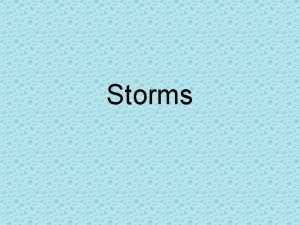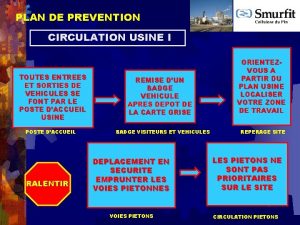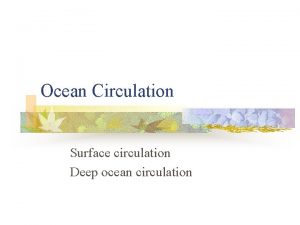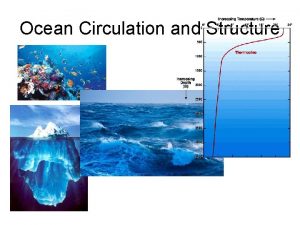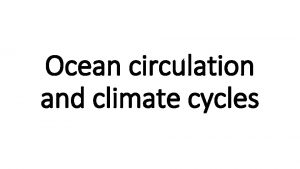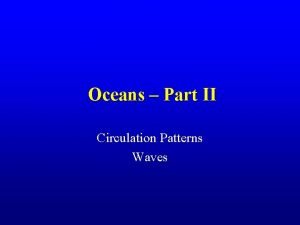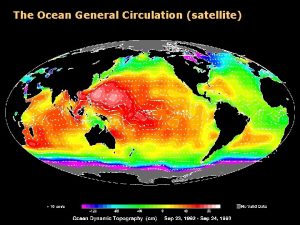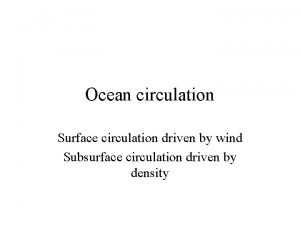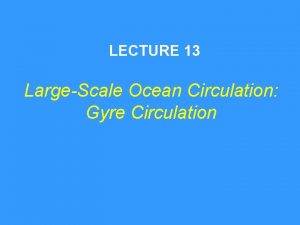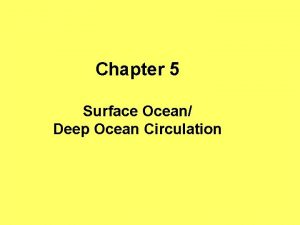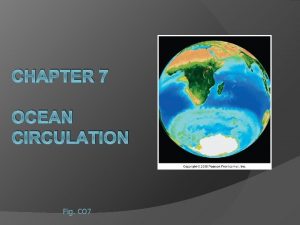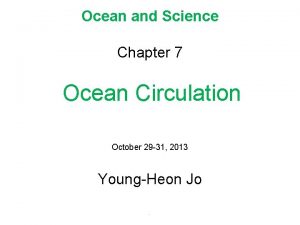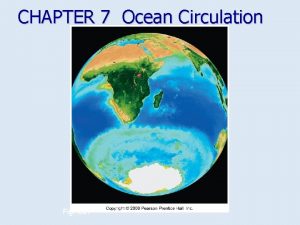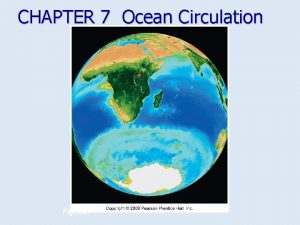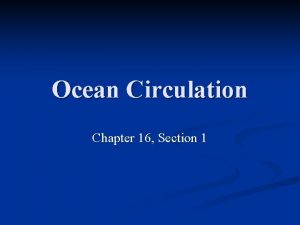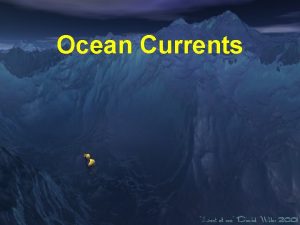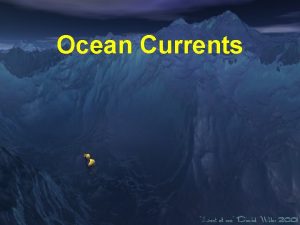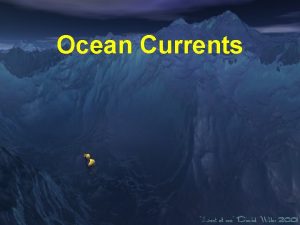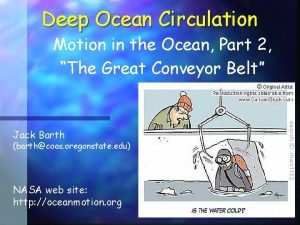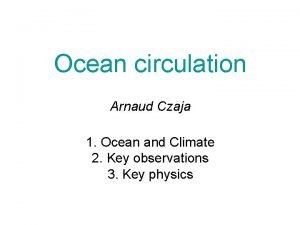Chapter 9 Ocean Circulation Chapter 9 Concepts Ocean

























- Slides: 25

Chapter 9: Ocean Circulation

Chapter 9 Concepts Ocean circulation is driven by winds and by differences in water density Surface currents are wind-driven movements of sea water Thermohaline currents (variations in water’s temperature and salinity) are the slow, deep Large surface currents move in circular gyres, along the peripheries of major ocean basins El Niño is an exception to normal wind and current flow Distinct water masses form at the ocean surface and often retain their distinct properties as they sink and sort into identifiable layers

Mass Flow of Ocean Water Is Driven by Wind and Gravity Currents are the mass flow of water. Surface currents are wind-driven movements of water at or near the ocean’s surface. Thermohaline currents are the slow, deep currents that affect the vast bulk of seawater beneath the pycnocline. Both have very important influences on Earth’s temperature, climate, and biological productivity, and will change as Earth’s climate varies.

Surface Currents Are Driven by the Winds, driven by uneven solar heating and Earth’s spin, drive the movement of the ocean’s surface currents. About 10% of the water in the world ocean is involved in surface currents. These currents are driven mainly by wind friction.

Surface Currents Are Driven by the Winds A combination of four forces: surface winds, the sun’s heat, the Coriolis effect, and gravity form circular currents called gyres. Gyres circulate: • • Clockwise in the Northern Hemisphere Counterclockwise in the Southern Hemisphere. The North Atlantic gyre, a series of four interconnecting currents with different flow characteristics and temperatures.

Surface Currents Flow around the Periphery of Ocean Basins Surface water blown by the winds at point A will veer to the right of its initial path and continue eastward. Water at point B veers right and continues westward.

Surface Currents Flow around the Periphery of Ocean Basins The Ekman spiral model. A body of water can be thought of as a set of layers. Each layer below is moved by friction. Each succeeding layer moves with a slower speed and at an angle to the layer immediately above. The theoretical net flow of water in the Northern Hemisphere is 90° to the prevailing wind force.

Surface Currents Flow around the Periphery of Ocean Basins The effect of the Ekman Spiral and the Coriolis effect cause the water within a gyre to move in a circular pattern. The movement of water away from point B is influenced by the rightward tendency of the Coriolis effect and the gravitypowered movement of water down the pressure gradient.

Tr ad e w in d 90° to the right of wind direction is up here 5° – 4 30° At 15°N Stepped Art Figure 9 -6 p 267

Surface Currents Flow around the Periphery of Ocean Basins The hill of water in the North Atlantic. (a) The surface of the North Atlantic is raised through wind motion and Ekman transport to form a low hill. The westward-moving water is balanced between the Coriolis effect and flow down the pressure gradient, driven by gravity. Thus, water in a gyre moves along the outside edge of an ocean basin. (b) The hill is formed by Ekman transport. Water turns clockwise (inward) to form the dome, then descends, depressing thermocline.

Seawater Flows in Six Great Surface Circuits Geostrophic gyres are gyres in balance between the pressure gradient and the Coriolis effect. Of the six great currents in the world’s ocean, five are geostrophic gyres. A chart showing the names and usual direction of the world ocean’s major surface currents. The powerful western boundary currents flow along the western boundaries of ocean basins in both hemispheres.

Boundary Currents Have Different Characteristics • Western boundary currents – These are narrow, deep, fast currents found at the western boundaries of ocean basins. – The Gulf Stream, Japan Current, and the Brazil Current – Agulhas Current and the Eastern Australian Current • Eastern boundary currents – These currents are cold, shallow and broad, and their boundaries are not well defined. – The Canary Current, Benguela Current, and the California Current – The West Australian Current and Peru Current

Boundary Currents Have Different Characteristics The western boundary of the Gulf Stream is usually distinct, marked by abrupt changes in water temperature, speed, and direction. Meanders (eddies) form at this boundary as the Gulf Stream leaves the U. S. coast at Cape Hatteras. The meanders can pinch off and eventually become isolated cells of warm water. Likewise, cold cells can pinch off and become entrained in the Gulf Stream itself.

Boundary Currents Have Different Characteristics Influence of the Coriolis effect on westward intensification. Because the Coriolis effect is strongest near the poles, water flowing eastward at high latitudes turns sooner to the right. Western boundary currents are therefore faster and deeper than eastern boundary currents, and the geostrophic hill is offset to the west. (b) Cross section of geostrophic flow in the North Atlantic. (a)

Surface Currents Affect Weather and Climate General summer air circulation patterns of the east and west coasts of the United States. Warm ocean currents are shown in orange; cold currents, in blue. Air is chilled as it approaches the west coast and warmed as it approaches the east coast.

Wind Can Cause Vertical Movement of Ocean Water • Wind-induced vertical circulation is vertical movement induced by winddriven horizontal movement of water. • Upwelling is the upward motion of water. This motion brings cold, nutrient rich water towards the surface. • Downwelling is downward motion of water. It supplies the deeper ocean with dissolved gases.

Nutrient-Rich Water Rises Near the Equator (a) (LEFT TOP) Equatorial upwelling. Water north of the equator veers to the right (northward), and water to the south veers to the left (southward). Surface water therefore diverges, causing upwelling. (b) (LEFT BOTTOM) The red, orange, and yellow colors mark the areas of greatest upwelling as determined by biological productivity.

Wind Can Induce Upwelling Near Coasts Coastal upwelling. In the Northern Hemisphere, coastal upwelling moves water offshore by Ekman transport is replaced by cold water. Satellite view of the U. S. west coast shows the growth of small, plantlike organisms stimulated by upwelled nutrients.

Wind Can Also Induce Coastal Downwelling Coastal downwelling Wind blowing from the south along a Northern Hemisphere west coast for a prolonged period can result in downwelling. Areas of downwelling are often low in nutrients and therefore relatively low in biological productivity.

El Niño and La Niña Are Exceptions to Normal Wind and Current Flow In a non-El Niño year, normally the air and surface water flow westward, thermocline rises, and upwelling of cold water occurs along the west coast of Central and South America. (FIGURES ON NEXT SLIDE) In an El Niño year, when the Southern Oscillation develops, the trade winds diminish and then reverse, leading to an eastward movement of warm water along the equator. The surface waters of the central and eastern Pacific become warmer, and storms over land may increase. Normal circulation sometimes returns with surprising vigor, producing strong currents, powerful upwelling, and chilly and dry conditions along the South American coast. These contrasting colder-thannormal events are called La Niña.

El Niño and La Niña Are Exceptions to Normal Wind and Current Flow A Non-El Niño Year An El Niño Year

El Niño and La Niña Are Exceptions to Normal Wind and Current Flow El Niño changes atmospheric circulation and weather patterns. (a) During an El Niño, low atmospheric pressure south of Alaska allows storms to move unimpeded to the Pacific coast of North America. (b) In La Niña years, high atmospheric pressure south of Alaska blocks the storm track.

Thermohaline Circulation Affects All the Ocean’s Water • The movement of water due to different densities is thermohaline circulation. • Because the ocean is density stratified, the densest (heaviest) water is at the bottom. • There are five common water masses: – Surface water – Central water – Intermediate water – Deep water – Bottom water

Thermohaline Flow and Surface Flow: The Global Heat Connection The global pattern of deep circulation resembles a vast “conveyor belt” that carries surface water to the depths and back again. The whole slow-moving system is important in transporting water and heat.

Water Masses May Converge, Fall, Travel across the Seabed, and Slowly Rise A simplified view of thermohaline circulation in the Atlantic. • • • Surface water becomes dense and sinks in the north and south polar regions. Being denser, Antarctic Bottom Water slips beneath North Atlantic Deep Water. The water then gradually rises across a very large area in the tropical and temperate zones, then flows pole- ward to repeat the cycle. As noted in the text, freshwater arriving in the North Atlantic from rapidly melting polar ice could slow the formation of North Atlantic Deep Water with profound implications for the climate of Europe.
 Single vs double circulatory system
Single vs double circulatory system Single circulation and double circulation
Single circulation and double circulation Alveoli definition
Alveoli definition Slowing atlantic ocean circulation
Slowing atlantic ocean circulation Chapter 15 ocean water and ocean life answer key
Chapter 15 ocean water and ocean life answer key Chapter 37 respiration circulation and excretion
Chapter 37 respiration circulation and excretion Concept mapping circulation in humans chapter 34
Concept mapping circulation in humans chapter 34 Chapter 34 circulation in humans concept mapping answer key
Chapter 34 circulation in humans concept mapping answer key Chapter 14 circulation and blood vessels
Chapter 14 circulation and blood vessels Chapter 42 circulation and gas exchange
Chapter 42 circulation and gas exchange Types of capillaries
Types of capillaries Divergent and convergent plate boundaries
Divergent and convergent plate boundaries Ocean ocean convergent boundary
Ocean ocean convergent boundary Convergent boundary
Convergent boundary Ocean ocean convergent boundary
Ocean ocean convergent boundary Ice age crack
Ice age crack Ocean to ocean convergent boundary
Ocean to ocean convergent boundary Blue ocean strategi
Blue ocean strategi Two circulation syndrome
Two circulation syndrome Blood flow circuit
Blood flow circuit Circulatory pathway
Circulatory pathway Large scale rotating air mass
Large scale rotating air mass Portal system
Portal system Exemple plan de circulation usine
Exemple plan de circulation usine Brain fish
Brain fish Refugee ap human geography definition
Refugee ap human geography definition





